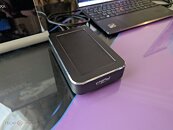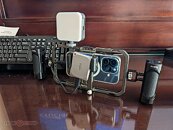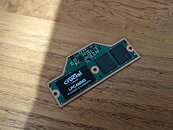- Joined
- Oct 9, 2007
- Messages
- 47,598 (7.45/day)
- Location
- Dublin, Ireland
| System Name | RBMK-1000 |
|---|---|
| Processor | AMD Ryzen 7 5700G |
| Motherboard | Gigabyte B550 AORUS Elite V2 |
| Cooling | DeepCool Gammax L240 V2 |
| Memory | 2x 16GB DDR4-3200 |
| Video Card(s) | Galax RTX 4070 Ti EX |
| Storage | Samsung 990 1TB |
| Display(s) | BenQ 1440p 60 Hz 27-inch |
| Case | Corsair Carbide 100R |
| Audio Device(s) | ASUS SupremeFX S1220A |
| Power Supply | Cooler Master MWE Gold 650W |
| Mouse | ASUS ROG Strix Impact |
| Keyboard | Gamdias Hermes E2 |
| Software | Windows 11 Pro |
Crucial, the client-focused brand of memory giant Micron Technology, showed off a handful new innovations at its booth along the sidelines of the 2024 International CES. First up, is a prototype USB4 portable SSD and prototype desktop SSD. These are proofs of concept, and not actual products. With this, Crucial is testing the waters with USB4 and its delicious 40 Gbps bidirectional bandwidth, which unlocks a new generation of fast removable storage devices. The prototype USB4 portable SSD comes in a tiny chassis about the size of a burner phone. It is a PCB with an M.2-2280 slot with PCIe Gen 4 x4 wiring, connected to an ASMedia ASM2464PD USB4 bridge chip. An OEM Micron Gen 4 SSD with 232-layer 3D TLC NAND flash and LPDDR4 DRAM cache, is installed on this drive. The CDM reading for this drive is 3821 MB/s sequential reads, with 885 MB/s sequential writes.
Next up, is a larger desktop SSD prototype (which again, isn't an actual product but a proof of concept). Its metal chassis is about the size of a 3.5-inch HDD. Inside is at least one M.2-2280 Gen 4 slot (there are probably more); with a preinstalled drive. An ASMedia ASM2464PD handles things here, too. The performance is mostly similar, at 3792 MB/s sequential reads, but with significantly increase 3803 MB/s sequential writes. This may seem unspectacular because Thunderbolt 4 has been delivering 40 Gbps for many years now, and we've had TB4-based external SSDs; but USB4 somewhat democratizes this kind of bandwidth.




Next up, Crucial announced that its X9 Pro, X9 Pro for Mac, and X10 Pro portable SSDs will come with a few new firmware update that lets it work with the iPhone 15 series (which have USB type-C). While the iPhone 15 and 15 Plus have the USB part of it capped at USB 2.0 480 Mbps, the 15 Pro and 15 Pro Max enable USB 3.1 up to 5 Gbps. This paves the way for fast storage devices that your iPhones can write high-resolution videos and RAW images to. These drives come in capacities of up to 4 TB, which can hold over 5 hours of 4K 60 FPS footage in lossless formats.



Lastly, we went hands-on with Crucial's LPCAMM2 module, which simplifies the design of DDR5 and LPDDR5 memory for ultraportable notebooks. Most contemporary ultraportables have non-upgradable LPDDR5 memory that's hardwired to the mainboard, because SO-DIMM slots add serious amounts of Z-height, not to mention, they're really inefficient with their PCB footprint. The LPCAMM2 form-factor addresses this. A single, fully replaceable module, has its contact points on one side, and on the other side it has the DRAM chips and PMIC. The full LPDDR5 bus width of a 160-bit capable mobile processor is utilized. The PCB footprint is less than that of a single SO-DIMM slot, with less than half its Z-height.
View at TechPowerUp Main Site
Next up, is a larger desktop SSD prototype (which again, isn't an actual product but a proof of concept). Its metal chassis is about the size of a 3.5-inch HDD. Inside is at least one M.2-2280 Gen 4 slot (there are probably more); with a preinstalled drive. An ASMedia ASM2464PD handles things here, too. The performance is mostly similar, at 3792 MB/s sequential reads, but with significantly increase 3803 MB/s sequential writes. This may seem unspectacular because Thunderbolt 4 has been delivering 40 Gbps for many years now, and we've had TB4-based external SSDs; but USB4 somewhat democratizes this kind of bandwidth.




Next up, Crucial announced that its X9 Pro, X9 Pro for Mac, and X10 Pro portable SSDs will come with a few new firmware update that lets it work with the iPhone 15 series (which have USB type-C). While the iPhone 15 and 15 Plus have the USB part of it capped at USB 2.0 480 Mbps, the 15 Pro and 15 Pro Max enable USB 3.1 up to 5 Gbps. This paves the way for fast storage devices that your iPhones can write high-resolution videos and RAW images to. These drives come in capacities of up to 4 TB, which can hold over 5 hours of 4K 60 FPS footage in lossless formats.



Lastly, we went hands-on with Crucial's LPCAMM2 module, which simplifies the design of DDR5 and LPDDR5 memory for ultraportable notebooks. Most contemporary ultraportables have non-upgradable LPDDR5 memory that's hardwired to the mainboard, because SO-DIMM slots add serious amounts of Z-height, not to mention, they're really inefficient with their PCB footprint. The LPCAMM2 form-factor addresses this. A single, fully replaceable module, has its contact points on one side, and on the other side it has the DRAM chips and PMIC. The full LPDDR5 bus width of a 160-bit capable mobile processor is utilized. The PCB footprint is less than that of a single SO-DIMM slot, with less than half its Z-height.
View at TechPowerUp Main Site


